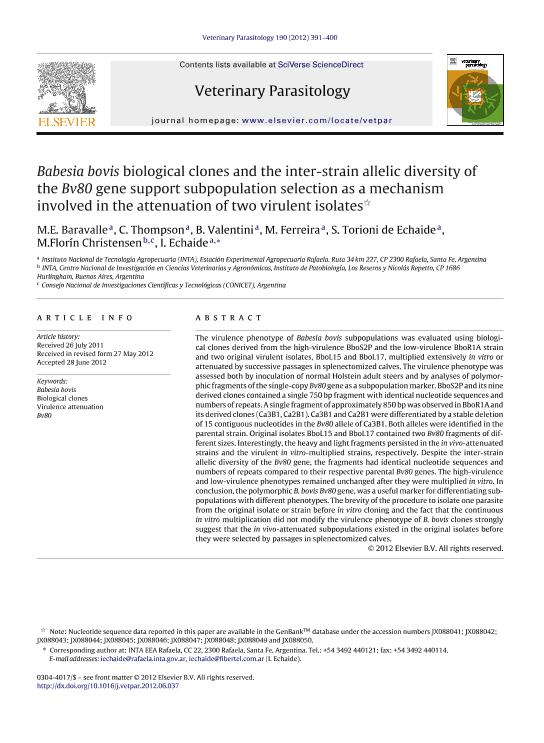Artículo
Babesia bovis biological clones and the inter-strain allelic diversity of the Bv80 gene support subpopulation selection as a mechanism involved in the attenuation of two virulent isolates
Baravalle, María Eugenia ; Thompson, Carolina Soledad; Valentini, B.; Ferreira, M.; Torioni de Echaide, Susana Marta; Christensen, M. Florín; Echaide, Ignacio Eduardo
; Thompson, Carolina Soledad; Valentini, B.; Ferreira, M.; Torioni de Echaide, Susana Marta; Christensen, M. Florín; Echaide, Ignacio Eduardo
 ; Thompson, Carolina Soledad; Valentini, B.; Ferreira, M.; Torioni de Echaide, Susana Marta; Christensen, M. Florín; Echaide, Ignacio Eduardo
; Thompson, Carolina Soledad; Valentini, B.; Ferreira, M.; Torioni de Echaide, Susana Marta; Christensen, M. Florín; Echaide, Ignacio Eduardo
Fecha de publicación:
06/2012
Editorial:
Elsevier Science
Revista:
Veterinary Parasitology
ISSN:
0304-4017
Idioma:
Inglés
Tipo de recurso:
Artículo publicado
Clasificación temática:
Resumen
The virulence phenotype of Babesia bovis subpopulations was evaluated using biological clones derived from the high-virulence BboS2P and the low-virulence BboR1A strain and two original virulent isolates, BboL15 and BboL17, multiplied extensively in vitro or attenuated by successive passages in splenectomized calves. The virulence phenotype was assessed both by inoculation of normal Holstein adult steers and by analyses of polymorphic fragments of the single-copy Bv80 gene as a subpopulation marker. BboS2P and its nine derived clones contained a single 750 bp fragment with identical nucleotide sequences and numbers of repeats. A single fragment of approximately 850 bp was observed in BboR1A and its derived clones (Ca3B1, Ca2B1). Ca3B1 and Ca2B1 were differentiated by a stable deletion of 15 contiguous nucleotides in the Bv80 allele of Ca3B1. Both alleles were identified in the parental strain. Original isolates BboL15 and BboL17 contained two Bv80 fragments of different sizes. Interestingly, the heavy and light fragments persisted in the in vivo-attenuated strains and the virulent in vitro-multiplied strains, respectively. Despite the inter-strain allelic diversity of the Bv80 gene, the fragments had identical nucleotide sequences and numbers of repeats compared to their respective parental Bv80 genes. The high-virulence and low-virulence phenotypes remained unchanged after they were multiplied in vitro. In conclusion, the polymorphic B. bovis Bv80 gene, was a useful marker for differentiating subpopulations with different phenotypes. The brevity of the procedure to isolate one parasite from the original isolate or strain before in vitro cloning and the fact that the continuous in vitro multiplication did not modify the virulence phenotype of B. bovis clones strongly suggest that the in vivo-attenuated subpopulations existed in the original isolates before they were selected by passages in splenectomized calves.
Palabras clave:
BABESIA BOVIS
,
BIOLOGICAL CLONES
,
BV80
,
VIRULENCE ATTENUATION
Archivos asociados
Licencia
Identificadores
Colecciones
Articulos(SEDE CENTRAL)
Articulos de SEDE CENTRAL
Articulos de SEDE CENTRAL
Citación
Baravalle, María Eugenia; Thompson, Carolina Soledad; Valentini, B.; Ferreira, M.; Torioni de Echaide, Susana Marta; et al.; Babesia bovis biological clones and the inter-strain allelic diversity of the Bv80 gene support subpopulation selection as a mechanism involved in the attenuation of two virulent isolates; Elsevier Science; Veterinary Parasitology; 190; 3-4; 6-2012; 391-400
Compartir
Altmétricas



